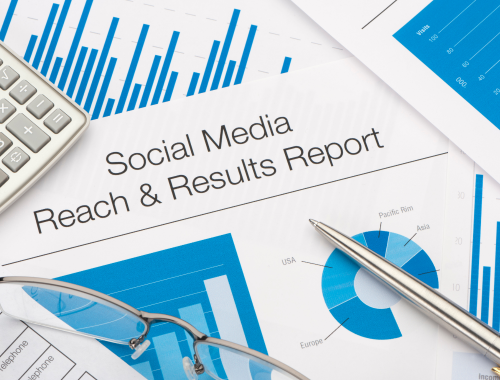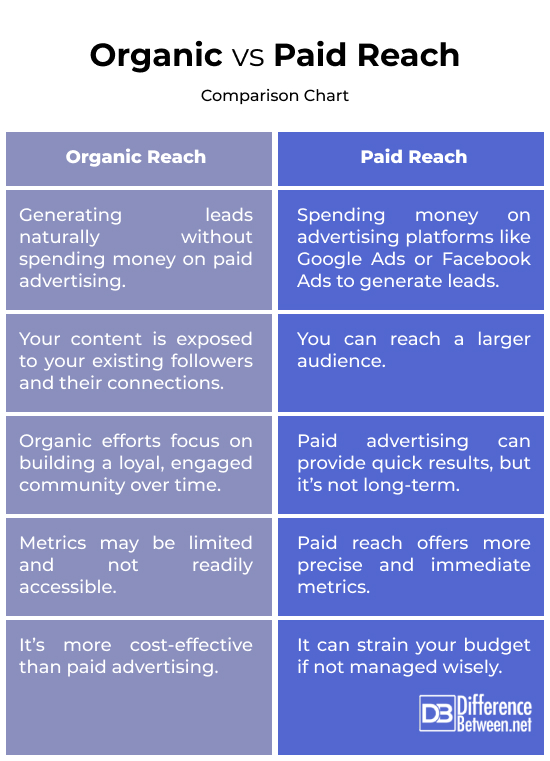Difference Between Organic and Paid Reach on Social Media Platforms
Every day we see big brands like Amazon, Apple, Spotify, Wendy’s, Burger King, Tesla, Nike, Coca-Cola, etc., to name a few, connect with their customers in new and unique ways through social platforms. In today’s digital world, it’s very important to have a strong online presence if you want to stand out from the rest. And one of the best ways you can do that is to start a social media marketing campaign.
To get the most out of your social media campaign, it’s important to invest in organic and paid search.
However, your social media campaign is only as good as your reach, and none of it will make sense if you can’t reach your target audience. In this article, we talk about organic and paid social media and how they can benefit your social media campaign. Here’s a quick organic vs. paid reach comparison to help you understand the concepts better.

Organic Reach
Imagine you have a business, and you grow it naturally without spending money on marketing campaigns or advertisements. Organic reach is similar. It’s when people find your content naturally without you paying for ads. It’s like free word-of-mouth promotion for your content. This happens because your content is so good that search engines like Google think it’s valuable and show it to people when they search for related topics.
Organic reach is when you share something on social media and some of your friends and their friends see it. It’s free and helps you connect with people who like what you post. For businesses, it’s a way to show their personality, build relationships, and help customers.

Paid Reach
Now, think of paid reach as buying an ad in a newspaper or on TV to promote your business. In the digital world, paid reach means spending money on advertising platforms like Google Ads or Facebook Ads to get your content in front of as many people as you can. You can choose your audience, so your ads will be visible only to them. Paid reach is more targeted and effective in terms of visibility and reach.
Paid reach is when businesses pay social media platforms to show their posts to specific people who might be interested. It’s like putting up a billboard on a busy road. It helps businesses attract new customers, share deals, and make more sales.
Difference between Organic and Paid Reach
Cost: One of the major differences between the two is cost. Organic marketing is the most cost-effective option, as it doesn’t require any considerable financial investment. It’s like free word-of-mouth promotion for your content. Paid marketing, however, comes with a price tag. You set a budget, and your content is shown to a targeted audience. While it can yield quicker results, especially for promotions and campaigns, it can strain your budget if not managed wisely.
Reach: While organic content is effective, your reach is limited. Your content is exposed to your existing followers and their connections, limiting your control over who sees it. It relies on the interests of your current audience and those who interact with your content. With paid advertising, you can reach a larger audience. You have the power to target your audience based on demographics, interests, and behaviors. You can be confident that your content targets only your ideal customers.
Sustainability: Organic efforts focus on building a loyal, engaged community over time. While it may take longer to see substantial growth, it lays the foundation for sustainable, long-term success and brand loyalty. Paid advertising can provide quick results, but it’s not long-term. If you stop investing in ads, traffic and engagement may decline. It’s ideal for immediate campaigns but may not foster long-term brand loyalty.
Measurability: While both organic and paid reach can be measured, paid reach offers more precise and immediate metrics. Metrics for organic reach emphasize the quality of your content and its ability to resonate with your audience. With paid advertising, you can track important metrics like click-through rate (CTR), conversion rate, cost per click (CPC), return on investment (ROI), and many more. These are accurate and easily accessible.
Organic vs. Paid Reach: Comparison Chart

Summary
At the end of the day, the decision between organic and paid reach depends on your requirements and preferences. Organic reach can be the best option for a cost-effective, sustainable strategy. Paid reach, on the other hand, might be an effective technique if you require immediate results and have extra money to spare. Often, a balanced approach that blends paid and organic efforts can yield the best results.
FAQs
What is the difference between organic reach and paid reach?
Organic reach is when people find your content naturally without you paying for them. Paid reach means you spend money to make your content seen by more people.
What is the difference between paid and organic channels?
- Paid channels: You pay platforms like Google, Facebook, or Instagram to show your content to their users. It’s a bit like renting a shop in a mall to attract customers.
- Organic channels: These are the places where you share your content without paying. It’s like talking to your friends and family about your business.
What is the difference between organic and paid impressions?
- Organic impressions: On social media, it’s the number of times your posts are displayed to users without you spending money.
- Paid impressions: Paid impressions are the number of times your content is shown to people because you paid for advertising. It’s a result of your advertising efforts.
What is paid reach on social media?
This is when you spend money to make sure your social media posts are seen by a larger audience. For example, if you want more people to see your blog post or a product you’re selling, you might pay a social media platform to show it to users who fit your target audience.
What is organic reach on social media?
Organic reach is when your posts get seen by people without you spending money on advertising. It happens because your followers or people who follow related hashtags come across your content naturally in their feed.
- Difference Between Caucus and Primary - June 18, 2024
- Difference Between PPO and POS - May 30, 2024
- Difference Between RFID and NFC - May 28, 2024
Search DifferenceBetween.net :
Leave a Response
References :
[0]Butow, Eric, et al. Ultimate Guide to Social Media Marketing. Entrepreneur Press, 2020.
[1]McMurtry, Jeanette Maw. Marketing for Dummies. John Wiley and Sons, 2022.
[2]Cooper, Paige. “Paid Vs. Organic Social Media: How to Integrate Both Into Your Strategy.” Hootsuite Blog, 1 Nov. 2021, blog.hootsuite.com/organic-vs-paid-social-media/.
[3]“Organic Vs. Paid Reach: Why Your Business Needs Both.” Ingenia, 9 June 2022, ingenia.com/news/2022/06/09/organic-vs.-paid-reach-why-your-business-needs-both/.
[4]Zelefsky, Victoria. “The Differences Between Paid and Organic Content on Social Media.” Forbes, 6 May 2022, www.forbes.com/sites/forbescommunicationscouncil/2022/05/06/the-differences-between-paid-and-organic-content-on-social-media.
[5]“Organic Vs Paid Social Media: Choose the Right Channel.” Sprinklr, 22 May 2023, www.sprinklr.com/blog/organic-vs-paid-social-media/.
[6]Irvine, Camille. “Organic Vs. Paid Advertising: Which Strategy Should Your Agency Use in 2023?” SocialPilot, 3 Mar. 2023, www.socialpilot.co/agency-success-guide/organic-vs-paid-advertising.
[7]Image credit: https://www.canva.com/photos/MAEFBzORG_M-social-media-marketing-network-communication-mobile-phone-app/
[8]Image credit: https://www.canva.com/photos/MAEE_A7_Hv8-social-media-results-report/
